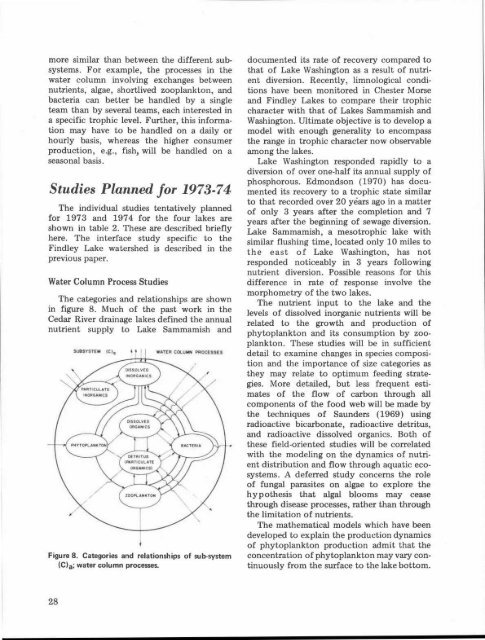PE EIE[R-Rg RESEARCH ON - HJ Andrews Experimental Forest
PE EIE[R-Rg RESEARCH ON - HJ Andrews Experimental Forest
PE EIE[R-Rg RESEARCH ON - HJ Andrews Experimental Forest
You also want an ePaper? Increase the reach of your titles
YUMPU automatically turns print PDFs into web optimized ePapers that Google loves.
more similar than between the different subsystems<br />
. For example, the processes in the<br />
water column involving exchanges betwee n<br />
nutrients, algae, shortlived zooplankton, and<br />
bacteria can better be handled by a singl e<br />
team than by several teams, each interested i n<br />
a specific trophic level. Further, this information<br />
may have to be handled on a daily o r<br />
hourly basis, whereas the higher consumer<br />
production, e .g., fish, will be handled on a<br />
seasonal basis .<br />
Studies Planned for 1973-74<br />
The individual studies tentatively planne d<br />
for 1973 and 1974 for the four lakes are<br />
shown in table 2 . These are described briefl y<br />
here. The interface study specific to th e<br />
Findley Lake watershed is described in th e<br />
previous paper .<br />
Water Column Process Studie s<br />
The categories and relationships are show n<br />
in figure 8. Much of the past work in th e<br />
Cedar River drainage lakes defined the annua l<br />
nutrient supply to Lake Sammamish an d<br />
Figure 8 . Categories and relationships of sub-syste m<br />
(C)a ; water column processes .<br />
documented its rate of recovery compared t o<br />
that of Lake Washington as a result of nutrient<br />
diversion. Recently, limnological conditions<br />
have been monitored in Chester Mors e<br />
and Findley Lakes to compare their trophi c<br />
character with that of Lakes Sammamish an d<br />
Washington . Ultimate objective is to develop a<br />
model with enough generality to encompas s<br />
the range in trophic character now observabl e<br />
among the lakes .<br />
Lake Washington responded rapidly to a<br />
diversion of over one-half its annual supply o f<br />
phosphorous . Edmondson (1970) has documented<br />
its recovery to a trophic state simila r<br />
to that recorded over 20 years ago in a matte r<br />
of only 3 years after the completion and 7<br />
years after the beginning of sewage diversion .<br />
Lake Sammamish, a mesotrophic lake wit h<br />
similar flushing time, located only 10 miles t o<br />
the east of Lake Washington, has no t<br />
responded noticeably in 3 years following<br />
nutrient diversion . Possible reasons for this<br />
difference in rate of response involve th e<br />
morphometry of the two lakes .<br />
The nutrient input to the lake and the<br />
levels of dissolved inorganic nutrients will b e<br />
related to the growth and production of<br />
phytoplankton and its consumption by zoo -<br />
plankton . These studies will be in sufficient<br />
detail to examine changes in species composition<br />
and the importance of size categories a s<br />
they may relate to optimum feeding strategies.<br />
More detailed, but less frequent estimates<br />
of the flow of carbon through all<br />
components of the food web will be made by<br />
the techniques of Saunders (1969) usin g<br />
radioactive bicarbonate, radioactive detritus ,<br />
and radioactive dissolved organics . Both of<br />
these field-oriented studies will be correlate d<br />
with the modeling on the dynamics of nutrient<br />
distribution and flow through aquatic ecosystems.<br />
A deferred study concerns the rol e<br />
of fungal parasites on algae to explore the<br />
hypothesis that algal blooms may cease<br />
through disease processes, rather than throug h<br />
the limitation of nutrients .<br />
The mathematical models which have been<br />
developed to explain the production dynamic s<br />
of phytoplankton production admit that the<br />
concentration of phytoplankton may vary continuously<br />
from the surface to the lake bottom .<br />
28








